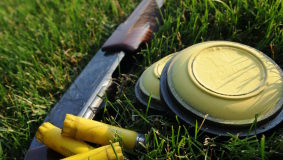|
Listen To The Article
|
 Re-loading shells is a dying art, I believe. As early as eight years old, I knew where the keg of gun powder was, and I knew not to leave it out in the light or humidity. I knew where a primer went and what it did. By fifteen, I was re-loading shells on my own. Once a week from early January each year until March, I finished my homework before dinner, then I sat in dad’s “gun room” with a box of primers, a bag of wads, and five pounds of shot and powder, making spent shells shoot again. We had a six-station shotgun shell re-loader back then, and by the sixth time I pulled the arm down, I had a shell and then one each pull after that if nothing went wrong. I always considered it a privilege and an honor to re-load dad’s shells. It felt good that he trusted me. Dad was very particular about everything he did, and when we were working with gun powder, we had to pay attention to every detail and be very precise.
Re-loading shells is a dying art, I believe. As early as eight years old, I knew where the keg of gun powder was, and I knew not to leave it out in the light or humidity. I knew where a primer went and what it did. By fifteen, I was re-loading shells on my own. Once a week from early January each year until March, I finished my homework before dinner, then I sat in dad’s “gun room” with a box of primers, a bag of wads, and five pounds of shot and powder, making spent shells shoot again. We had a six-station shotgun shell re-loader back then, and by the sixth time I pulled the arm down, I had a shell and then one each pull after that if nothing went wrong. I always considered it a privilege and an honor to re-load dad’s shells. It felt good that he trusted me. Dad was very particular about everything he did, and when we were working with gun powder, we had to pay attention to every detail and be very precise.
Back then we could go through 500 shells in a night behind the gun club at the trap shooting range. Nowadays they have rules against using re-loads in tournaments, but when I was young, I could make you a shell that would hold a wide pattern and get there quick, just like dad wanted. Let’s just say a little extra powder goes a long way.
One night when I was sixteen, my dad had a great night using my “special” re-loads, earning a “250 straight” patch for his hunting vest. This patch was the holy grail for trap shooters, and they came few and far between, even for the best shooters. A trap shooting round consisted of twenty-five clay pigeons coming from several different points on the range. A person had to go ten rounds straight without a miss to get that patch.
Afterwards in the club house, his peers were shaking his hand and patting him on the shoulder, and dad should have been smiling away, but he wasn’t. Each time someone would touch him in the arm or shoulder, dad would wince. Obviously, he was in pain.
I packed his guns into the truck, and he kind of hobbled out and got in. When we got home, he took his jacket off, revealing that his shoulder and cheek were black and blue. “I think you had too much powder in those shells,” were dad’s only words. I felt bad for a while, until I saw how proud he was of that patch. More than once after that, he had me make “special” shells.
Some of my fondest memories are inside that old clubhouse at the Sportsmen’s Club. Visions of the many beautifully ornamented and engraved shotguns lined against the wall just inside the club house doors are easily rendered to date. Each sportsman proudly showed off his best shotgun in that infamous gun rack. Dad’s best was a Browning over-under 20 gauge, with gold-plated triggers and scrollwork everywhere.
Last week I was cleaning out the barn and came across that old shell re-loader from the 1960s. I ventured into the house and found the old 1100-model Remington trap gun. With a full choke, vented rib, and a pink sight ball at the far end of the barrel, this gun was built to pick up, shoot, and put back down. It weighed more than two field guns, making it the “Cadillac” of shotguns.
I found some spent 12-gauge shells and a bag of plastic wads, then I found a box of primers, some shot, and powder. Within a few minutes, I had a half box of my “special” re-loads. This weekend I will show the boys a thing or two about trap shooting. Hopefully, I got the mix just right. Wish me luck.
 Off The Grid News Better Ideas For Off The Grid Living
Off The Grid News Better Ideas For Off The Grid Living
